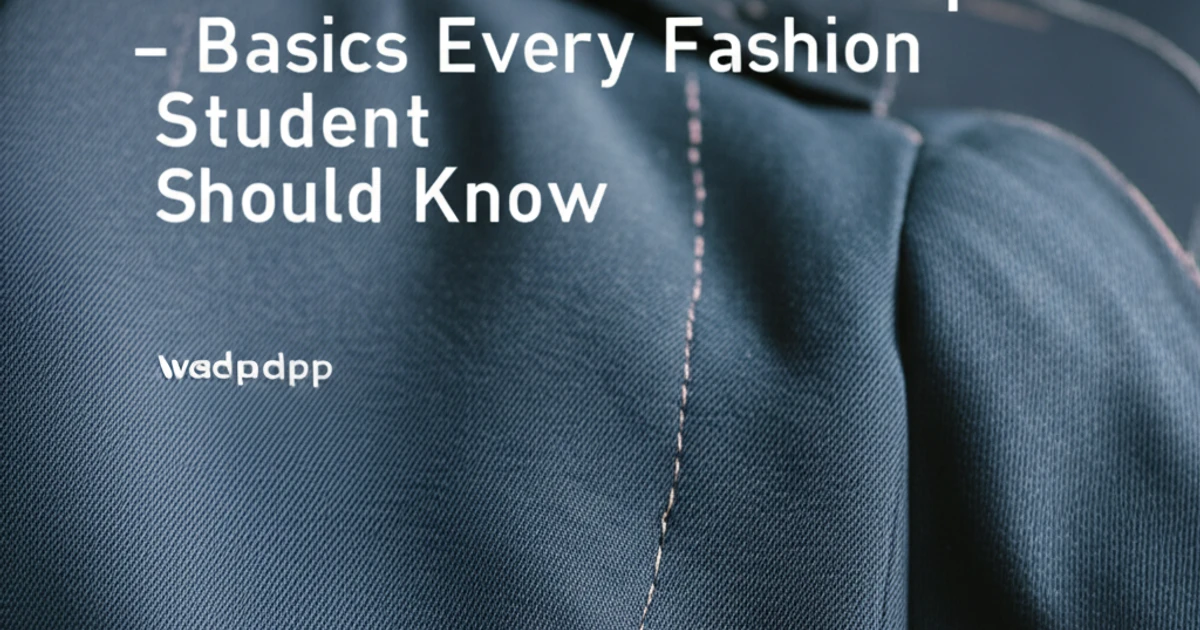Unraveling the Fabric: Garment Construction Explained – Garment Construction Basics Every Fashion Student Should Know
Hey there, future design mavens and fashion dreamers! Ever stood in front of a stunning runway piece, marveling at its artistry, and wondered, “How on earth did they *make* that?” Or perhaps you’ve sketched a brilliant design, only to feel a pang of uncertainty about how it would actually come to life, stitch by stitch? If so, you’re exactly where I was once upon a time, overflowing with ideas but a little daunted by the technicalities.
Today, we’re going on an exciting journey into the very heart of fashion: garment construction basics. This isn’t just about sewing; it’s about understanding the DNA of clothing, the silent language that transforms a flat piece of fabric into a wearable masterpiece. For any fashion student, aspiring designer, or even a curious beginner, mastering these fundamentals is your superpower. It’s what separates a good design from a truly exceptional one, a fleeting trend from a timeless creation. Trust me, once you grasp these fashion design fundamentals, your sketches will gain depth, your ideas will become tangible, and your confidence will soar. Let’s peel back the layers and discover the magic within!
Why Bother with the Bones? The Indispensable Core of Your Creations
Why do we spend so much time discussing seams, finishes, and the seemingly invisible aspects of clothing? Because garment construction is the *spine* of your design. Think about it: a magnificent architectural blueprint is useless without sturdy foundations and walls. The same goes for fashion. You could have the most breathtaking sketch in the world, a concept that could redefine an era, but if it sags, pulls, tears, or simply doesn’t sit right on the body, its impact is lost.
Understanding the mechanics of garment making allows you to not just *draw* clothes, but to *engineer* them. It gives you the power to select the right fabric for the right drape, to envision how a dart will shape a silhouette, or how a specific seam will affect the garment’s movement. This deep knowledge empowers you to push boundaries responsibly, knowing precisely how far you can stretch the rules of construction before your artistic vision crumbles. It’s about building a solid, beautiful, and functional reality from your wildest dreams.
Decoding the Blueprint: What’s the Secret Language of Patterns?
Before a single stitch is made, there’s a silent hero, a crucial element that bridges the gap between your 2D sketch and a 3D reality: the pattern. If your design is the story, the pattern is its meticulously crafted screenplay. It’s a precise, flat representation of every piece of fabric needed to construct the garment, complete with markings for darts, seams, pleats, and grainlines. Learning to read and create patterns is perhaps the most critical fashion student guide entry you’ll ever encounter.
I still remember my first pattern-making class – a sheer rectangle of muslin and a seemingly simple skirt. My first attempt resulted in a garment that could’ve fit a house rather than a human. It was a humbling, yet invaluable lesson in precision, understanding negative space, and how a tiny adjustment on paper translates into a monumental shift on the body. A well-drafted pattern ensures not just the correct size, but also the garment’s balance, drape, and overall aesthetic. It’s where you define fit, proportion, and ultimately, the success of your design.
The Fabric’s Whisper: How Do Fabrics and Stitches Sing Together?
Fabric isn’t just a surface; it’s a living, breathing component with its own character, drape, and demands. And knowing how to make it sing with the right stitches and seams is pure artistry. Imagine trying to sew a delicate silk chiffon with a heavy-duty denim needle and thread – disaster, right? Or expecting a crisp, structured tailored jacket from a slinky knit fabric. Each material dictates a specific approach to garment making, from the type of needle and thread to the seam allowance and finishing technique.
Understanding fabric grain (warp and weft) is fundamental, as it dictates how a garment hangs and moves. Then there’s the universe of seams: plain seams, French seams (oh, the elegance!), flat-felled seams (for durability and a clean finish), and serged edges, to name a few. Each serves a purpose, offering different levels of strength, flexibility, and aesthetic appeal. Your choice of seam and finish reflects not just your technical skill, but also your understanding of the garment’s purpose and the fabric’s properties. It’s a subtle conversation between material and method, where durability meets delicacy.
The Art of the Finish: What Separates Good from Truly Great?
You’ve got your pieces cut, your seams sewn, but the journey isn’t over. The true mark of a professional, the often-overlooked secret ingredient in outstanding garment construction, lies in the finishing touches. These are the details that elevate a garment from “okay” to “exquisite,” often invisible to the untrained eye but felt in the quality and longevity of the piece. We’re talking about pressing, lining, interlining, and carefully selected closures.
A beautifully pressed seam can transform a piece of fabric, giving it crispness, structure, and a polished look that no amount of fancy stitching can replicate. Linings aren’t just for comfort; they provide structure, conceal raw edges, and allow a garment to slide smoothly over the body. Interlinings add shape and body to specific areas, like collars and cuffs. And closures – zippers, buttons, snaps, hooks and eyes – aren’t mere afterthoughts; they’re integral to the garment’s function and can be design elements in themselves. Mastering these details is a testament to your commitment to excellence and your comprehensive understanding of fashion design fundamentals.
Beyond the Seam: How Do You Master This Intricate Dance?
So, where do you begin your mastery of these garment construction basics? My advice is simple: practice, experiment, and embrace your mistakes as stepping stones. Start with simple projects – a basic tote bag, a pillowcase, or a simple skirt. Don’t be afraid to take things apart and put them back together. Every unravelled seam is a lesson learned.
Seek out resources: books, online tutorials, and most importantly, mentors. Watch how experienced pattern makers manipulate fabric, how skilled sewers handle their machines. Ask questions, even if they seem silly. Join workshops. And never, ever stop being curious about how things are made. The journey of mastering garment making is continuous, evolving with new techniques, fabrics, and technologies. It’s a skill that will empower you, unleash your creativity, and give you the confidence to turn any design dream into a wearable reality. Your hands are your most powerful tools; let them guide you in shaping the future of fashion.
The world of fashion is not just about glamour and grand statements; it’s built on a foundation of meticulous craftsmanship. By diving deep into garment construction, you’re not just learning a skill; you’re developing an appreciation for the artistry, the engineering, and the sheer dedication that goes into every single piece of clothing. So, roll up your sleeves, fire up your sewing machine, and start building your fashion future, one perfectly constructed seam at a time!


